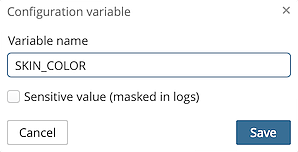Configuration variables make it possible to outsource parts of the configuration to environment variables. Configuration variables are resolved at configuration activation time during the startup of Airlock IAM. This way, it is possible to include values in the IAM configuration that are not yet available when creating the configuration.
Configuration environments vs. configuration variables
Some use cases of the configuration variables feature overlap with applications of the Configuration environments feature.
- The main difference between the two features are:
- Using the configuration environment feature, environment-specific values for all environments are stored in the IAM configuration file
medusa-configuration.xml. The environment-specific values, therefore, need to be known at configuration time. - Values are assigned to configuration variables at start-up time during configuration activation and do not have to be known at configuration time. Moreover, they are not stored in the IAM configuration file
medusa-configuration.xml.


